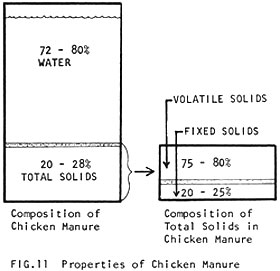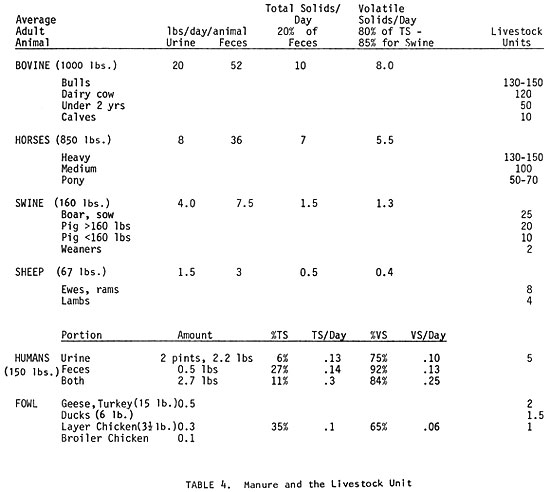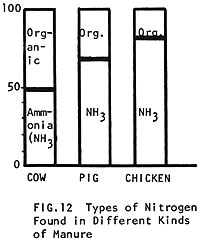4 Raw Materials
The amount and characteristics of organic materials (both plant and animal wastes) available for digestion vary widely. In rural areas, the digestible material will depend upon the climate, the type of agriculture practiced, the animals used and their degree of confinement, the methods of collecting wastes, etc. There are also degrees of quality and availability unique to urban wastes. Because of all these things, it is practically impossible to devise or use any formula or rule-of-thumb method for determining the amount and quality of organic wastes to be expected from any given source. There is, however, some basic information which is useful when you start wondering how much waste you can feed your digester.
Digestible Properties of Organic Matter
When raw materials are digested in a container, only part of the waste is actually converted into methane and sludge. Some of it is indigestible to varying degrees, and accumulates in the digester or passes out with the effluent and scum. The "digestibility" and other basic properties of organic matter are usually expressed in the following terms (see Ref. 16):
- Moisture: The weight of water lost upon drying at 220°F (105°C) until no more weight is lost.
- Total Solids (TS): The weight of dry material remaining after drying as above. TS weight is usually equivalent to "dry weight." (However, if you dry your material in the sun, assume that it will still contain around 30% moisture.) TS is composed of digestible organic or "Volatile Solids" (VS), and indigestible residues or "Fixed Solids."
- Volatile Solids(VS): The weight of organic solids burned off when dry material is "ignited" (heated to around 1000°F, 538°C). This is a handy property of organic matter to know, since VS can be considered as the amount of solids actually converted by the bacteria.
- Fixed Solids (FS): Weight remaining after ignition. This is biologically inert material.
As an example, consider the make-up of fresh chicken manure (Ref. 17).

So if we had 100 pounds of fresh chicken manure, 72-80 pounds of this would be water, and only 15-24 pounds (75-80% Volatile Solids of the 20-28% Total Solids) would be available for actual digestion.
Amount of Manure Collectable
When you see a table which shows the amount of manure produced by different kinds of livestock, it's important to know that the amount on the table may not be the amount that is actually available from your animals. There are three major reasons for this:
1) The Size (Age) Of The Animal
Consider the total wet manure production of different sized pigs:
40-80
80-120
120-160
160-200
(From 37)
So the size (age) of your livestock has a lot to do with the amount of manure produced. Notice that the ratio of total wet manure production to the weight of the pig is fairly constant. It is likely that similar ratios could be worked out for other kinds of livestock, enabling you to estimate the production of manure from the size of livestock.
2) The Degree of Livestock Confinement
Often the values given for manure production are for commercial animals which are totally confined. All of their manure can be collected. On the homestead or small farm, total confinement of the livestock is not always possible or even desirable. (Foraging and uncrowded livestock are less likely to contract diseases and more likely to increase the quality of their diet with naturally occurring foods.) Because of this, a large proportion of the manure is deposited in fields and thus hard to collect. For example, the fresh manure production of commercial chickens in total confinement is about 0.4 lbs. per chicken per day (Ref. 17, 28). However, for small-scale operations like homesteads and small farms, where preference tends to favor the well-being of the chickens rather than the economics of egg production, chickens are often allowed to forage all day and confined only at night. In such cases, only manure dropped during the night from roosts can be conveniently collected. In our experience, this may amount to only about 0.1 to 0.2 pounds of fresh manure per day per adult chicken. Similar reasoning holds for other livestock.
3) The Kind of Manure that is Collected
a) All the fresh excrement (feces and urine ).
b) All the fresh excrement plus the bedding material.
c) Wet feces only.
d) Dry feces only.
Manure Production and the Livestock Unit
Keeping in mind all these factors that can affect the type and amount of manure that can be collected, we can assemble a general manure production table. The table only shows rough average values obtained for many sources (Ref. 15, 17, 21--39). Values are expressed as the amount in pounds of wet manure, dry manure and volatile solids that could be expected from various adult livestock per day. For the table, an adult animal is: cow -- 1000 lbs; horse -- 850 lbs; swine -- 160 lbs; human -- 150 lbs; sheep -- 67 lbs; turkey -- 15 lbs; duck -- 6 lbs; chicken -- 3-1/2 lbs. (We need information on goats and rabbits.)
Table 4 enables us to get some idea of the production of readily digestible material (volatile solids) from different animals. Only the feces is considered for cows, horses, swine, and sheep, since their urine is difficult to collect. However, for humans and fowl, both urine and feces are given, since they are conveniently collected together.

The relative values of digestible wastes produced are not given in pounds of manure per animal per day, but in a more convenient relative unit called the "Livestock Unit." The table shows that on the average one medium horse would produce as much digestible manure as 4 large pigs, 12-1/2 ewes, 20 adult humans or 100 chickens.
Carbon to Nitrogen Ratio (C/N)
From a biological point of view, digesters can be considered as a culture of bacteria feeding upon and converting organic wastes. The elements carbon (in the form of carbohydrates) and nitrogen (as protein, nitrates, ammonia, etc.) are the chief foods of anaerobic bacteria. Carbon is utilized for energy and the nitrogen for building cell structures. These bacteria use up carbon about 30 times faster than they use nitrogen.
Anaerobic digestion proceeds best when raw material fed to the bacteria contains a certain amount of carbon and nitrogen together. The carbon to nitrogen ratio (C/N) represents the proportion of the two elements. A material with 15 times more carbon than nitrogen would have a C/N ratio of 15 to 1 (written C/N = 15/1, or simply 15).
A C/N ratio of 30 (C/N = 30/1, 30 times as much carbon as nitrogen) will permit digestion to proceed at an optimum rate, if other conditions are favorable, of course. If there is too much carbon (high C/N ratio; 60/1 for example) in the raw wastes, nitrogen will be used up first, with carbon left over. This will make the digester slow down. On the other hand, if there is too much nitrogen (low C/N ratio; 30/15 for example, or simply 2), the carbon soon becomes exhausted and fermentation stops. The remaining nitrogen will be lost as ammonia gas (NH3). This loss of nitrogen decreases the fertility of the effluent sludge.
There are many standard tables listing the C/N ratios of various organic materials, but they can be very misleading for at least two reasons:
- The ratio of carbon to nitrogen measured chemically in the laboratory is often not the same as the ratio of carbon to nitrogen available to the bacteria as food (some of the food could be indigestible to the bacteria; straw, lignin, etc.).
- The nitrogen or carbon content of even a specific kind of plant or animal waste can vary tremendously according to the age and growing conditions of the plant; and the diet, age, degree of confinement, etc., of the animal.
Nitrogen: Because nitrogen exists in so many chemical forms in nature (ammonia, NH3; nitrates, N03; proteins, etc.), there are no reliable "quick" tests for measuring the total amount of nitrogen in a given material. One kind of test might measure the organic and ammonia nitrogen (the Kjeldahl test), another might measure the nitrate/nitrite nitrogen, etc. Also, nitrogen can be measured in terms of wet weight, dry weight or volatile solids content of the material; all of which will give different values for the proportion of nitrogen. Finally, the nitrogen content of a specific kind of manure or plant waste can vary, depending on the growing conditions, age, diet, and so forth.
For example, one study reported a field of barley which contained 39% protein on the 21st day of growth, 12% protein on the 49th day (bloom stage), and only 4% protein on the 86th day (Ref. 18). You can see how much the protein nitrogen depends on the age of the plant.
The nitrogen content of manure also varies a great deal. Generally, manures consist of feces, urine and any bedding material (straw, corn stalks, hay, etc.) that may be used in the livestock shelters. Because urine is the animal's way of getting rid of excess nitrogen, the nitrogen content of manures is strongly affected by how much urine is collected with the feces.
For example, birds naturally excrete feces and urine in the same load, so that the nitrogen content of chickens, turkeys, ducks, and pigeons are highest of the animal manures in nitrogen content. Next in nitrogen content, because of their varied diets or grazing habits are humans, pigs, sheep, and then horses. Cattle and other ruminants (cud chewers) which rely on bacteria in their gut to digest plant foods, have a low content of manure nitrogen because much of the available nitrogen is used to feed their intestinal bacteria. (Fig.12)

Even with the same kind of animal there are big differences in the amount of manure-nitrogen. For example, stable manure of horses may have more nitrogen than pasture manure because feces and urine are excreted and collected in the same small place.
Since there are so many variables, and because anaerobic bacteria can use most forms of nitrogen, the available nitrogen content of organic materials can best be generalized and presented as total nitrogen (% of dry weight).
Carbon: Unlike nitrogen, carbon exists in many forms which are not directly useable by bacteria. The most common indigestible form of carbon is lignin, a complex plant compound which makes land plants rigid and decay-resistant. Lignin can enter a digester either directly with plant wastes themselves or indirectly as bedding or undigested plant food in manure. Thus, a more accurate picture of the C part of the C/N ratio is obtained when we consider the "non-lignin" carbon content of plant wastes.
Calculating C/N Ratios
Table 5 can be used to calculate roughly the C/N ratios of mixed raw materials. Consider the following examples:
Example 1
Calculate the C/N ratio of 50 lbs horse manure (C/N=25) and 50 lbs dry wheat straw (C/N=150).
Nitrogen in 50 lbs horse manure = 2.3% x 50 = 1.2 lbs
Carbon in 50 lbs horse manure = 25 times more than nitrogen = 25 x 1.2 = 30 lbs
Nitrogen in 50 lbs wheat straw = 0.5% x 50 = .25 lbs
Carbon in 50 lbs wheat straw = 150 times more than nitrogen = 150 x .25 = 37.5 lbs
-
Carbon
Nitrogen
C/N ratio = 67.5/1.45 = 46.5
Although a bit high, this would be a satisfactory ratio for most digestion purposes.
Example 2
Calculate the C/N ratio of 8 lbs grass clippings (C/N=12) and 2 lbs of chicken manure (C/N=15).
Nitrogen in 8 lbs grass clippings = 4% x 8 = .32 lbs
Carbon in 8 lbs grass clippings = 12 times more than nitrogen = 3.8 lbs
Nitrogen in 2 lbs chicken manure = 6.3% x 2 = .13 lbs
Carbon in 2 lbs chicken manure = 15 times more than nitrogen = 1.9 lbs
-
Carbon
Nitrogen
C/N ratio = 5.7/.45 = 12.6
The C/N ratio of this mixture is low. We might want to add a higher proportion of chicken manure since it contains more carbon per weight than the grass.
The following table is a summary of the important chemical properties of organic materials. Values are averages derived from many sources (Ref. 14, 16, 18--33) and should be used only for approximation
Carbon & Nitrogen Values of Wastes
-
% Dry weight
Animal Wastes
Urine
Blood
Bone Meal
-
Animal Tankage
-
Dry Fish Scraps
-
Manure
Human feces
Human urine
-
Chicken
Sheep
-
Pig
-
Horse
Sludge
Milorganite
-
Activated
Fresh Sewage
-
Plant Meals
Soybean
-
Cottonseed
-
Peanut Hull
-
Plant Wastes
Hay, Young Grass
Hay, Blue Grass
Seaweed
Non-Legume Vegetables
Red Clover
Straw, Oat
Straw, Wheat
Sawdust
Nitrogen is total nitrogen dry weight and carbon is either total carbon (dry weight) or (*) non-lignin carbon (dry weight).
Next: 5 The Gas
12 References
Back to Table of Contents
Back to the Biofuels Library
Back to the Small Farms Library
Biofuels
Biofuels Library
Biofuels supplies and suppliers
Biodiesel
Make your own biodiesel
Mike Pelly's recipe
Two-stage biodiesel process
FOOLPROOF biodiesel process
Biodiesel processors
Biodiesel in Hong Kong
Nitrogen Oxide emissions
Glycerine
Biodiesel resources on the Web
Do diesels have a future?
Vegetable oil yields and characteristics
Washing
Biodiesel and your vehicle
Food or fuel?
Straight vegetable oil as diesel fuel
Ethanol
Ethanol resources on the Web
Is ethanol energy-efficient?
